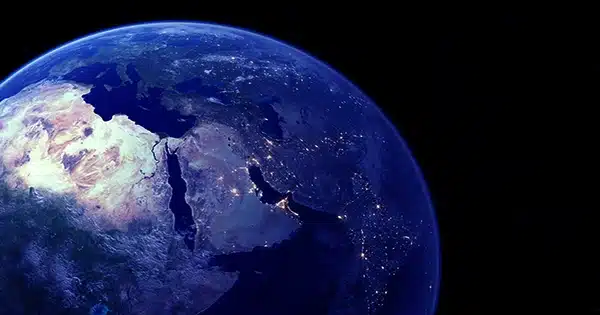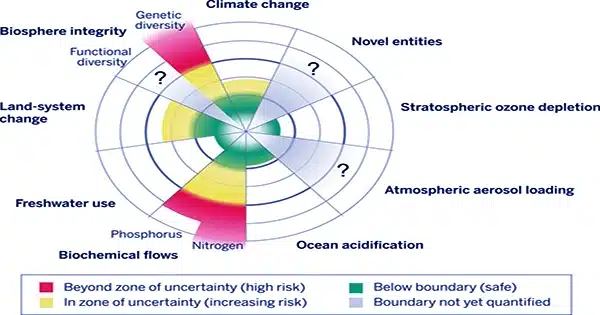A new study updates the planetary boundary framework, demonstrating that human activities are progressively harming the globe, raising the danger of catastrophic changes in general Earth conditions.
For almost 3 billion years, the interaction of life (represented by the planetary barrier, Biosphere Integrity) and climate has governed Earth’s general environmental circumstances. Human activities such as converting natural areas to various uses, changing the amount of water in rivers and soil, introducing synthetic chemicals into the open environment, and emitting greenhouse gases into the atmosphere all have an impact on these interactions.
Respecting and maintaining interactions in the Earth system that are similar to those that have controlled Earth’s conditions for the past 12,000 years is critical for ensuring that human activities do not cause dramatic changes in Earth’s conditions—changes that would likely reduce the Earth’s ability to support modern civilizations.
The nine “planetary boundaries” are components of the global environment that manage the planet’s stability and livability for humans. Human-driven activities affecting the components cause the degree of violation of the safe boundary levels.

The planetary boundaries framework uses the most recent scientific understanding of the Earth system’s functioning to identify a “safe operating space” for humanity by proposing limits for the extent to which human activities can be allowed to impact critical processes without potentially causing irreversible changes in the Earth conditions that support us.
Metrics for all boundaries are published for the first time. Six of the limits have been determined to be violated, and transgression is growing for all boundaries save the ozone depletion. A worldwide focus on climate is insufficient. A critical priority is the development of Earth system models that accurately recreate interactions between boundaries, particularly Climate and Biosphere Integrity.
The study, which was published in Science Advances, constitutes the framework’s third update, which was carried out by 29 experts from eight different nations.
The ‘blood pressure’ of the Earth is too high: According to Katherine Richardson, professor at Globe Institute, leader of the Sustainability Science Center at the University of Copenhagen, and study leader, the trend of increased transgression of boundaries is concerning. “Crossing six boundaries does not necessarily imply disaster, but it is a clear warning signal.” We can think of it like we would our own blood pressure. A blood pressure of more than 120/80 does not guarantee a heart attack, but it does raise the likelihood of one. As a result, we attempt to bring it down. We must minimize the pressure on these six planetary boundaries for our own and our children’s sake.”
An important finding of the study is that more emphasis should be placed on interactions between the borders. “Focusing on human-caused climate change is not enough if we want to protect the earth system from irreversible harm,” says Johan Rockström, Director of the Potsdam Institute for Climate Impact Research (PIK) and the framework’s original proposer in 2009.
“After climate change, the integrity of the biosphere is the second pillar of our planet’s stability.” “Our research shows that mitigating global warming and preserving a functional biosphere for the future must go hand in hand,” co-author Wolfgang Lucht, Head of PIK’s Earth System Analysis department, emphasizes.
Use of biomass affects biodiversity: The requirement to observe the Land usage Change border focuses attention on the growing global usage of biomass as an alternative to coal, oil, and gas. Biomass is a byproduct of photosynthesis, the process by which plants transform the sun’s energy into energy that can be used by other living organisms, thus providing the energy that sustains biodiversity.
“Our research shows that humans are appropriating 30% of the energy that was available to support biodiversity prior to the Industrial Revolution,” Richardson says.
“The removal of so much energy that would otherwise have been available to nature must surely be a driver of biodiversity loss.” As a result, we recommend using Human Appropriation of Net Primary Production (HANPP), or biomass consumption, as one of two criteria to evaluate human impacts on biodiversity.”
Better Earth system models are needed: “A world that develops within scientifically defined boundaries is the only way to navigate our current situation, which is fraught with rising, potentially catastrophic risks on a global scale.” We already recognize this in climate, where the Paris Agreement established a temperature planetary threshold of 1.5°C. Similarly, when it was determined at the 2022 Montreal-Kunming COP15 to halt and reverse biodiversity loss on land and in the ocean, the world recognized the global boundary on biodiversity,” says Johan Rockström.
“However, our research shows that this is far from sufficient.” The Planetary Boundaries research provides a ‘map for action’ if we truly want to achieve prosperity and equity for all on Earth, and this extends far beyond climate alone, necessitating unique Earth system modeling and analysis, as well as systematic actions to conserve, recover, and restore planetary resilience.”
“Hopefully, this new study will serve as a wake-up call for many and increase focus in the international community on the necessity of limiting our impacts on the planet in order to preserve and protect the Earth conditions that allow advanced human societies to flourish,” Katherine Richardson says.














